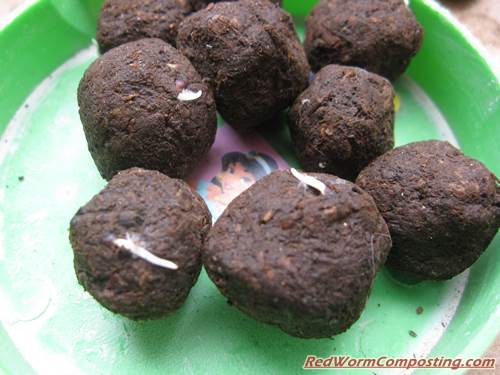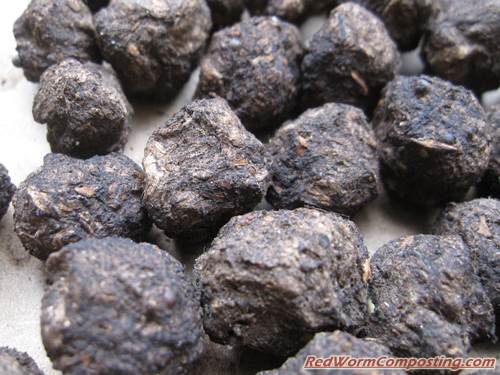Since the time of my last seed ball post, I have continued to experiment with my own mixes. Most recently – this past weekend – I decided to create a mix solely consisting of 50% vermicompost and 50% paper pulp to see what sort of a difference it would make (if any) to leave the clay out. I had recently received various bags of seeds for growing “microgreens” (another topic I’ll certainly be writing more about here fairly soon), so I thought it might be fun to create little microgreens seed balls – I chose “Red Russian” Kale seeds for this particular experiment.
The idea of having the seeds ready to go inside the growing medium just seemed to “make sense” to me, so I mixed about 15 g of the kale seeds into the vermicompost/paper pulp matrix before creating the seed balls. Then, I spent a ridiculously-long time creating literally 100’s of little kale seed balls (I wanted to make sure I used up the entire batch of seed ball matrix). Most of them were placed in front of heating fan to dry.
I thought I was being “smart” by making the seed balls really small and using warm air to dry them. But alas, I failed to take into consideration the fact that some seeds just germinate REALLY quickly!
So yeah, the long and the short of it is that while I did manage to dry out quite a few of the seed balls quickly enough (at least I think so), others started sprouting during the drying process! Looks like I’ll be eating lots of kale microgreens pretty soon!
😆
I also wanted to point out that while the vermicompost and paper pulp mix seemed to work very well without the clay as far as creating the seed balls went, what I found was that they lost a lot of their smooth shape as they dried. I don’t know that this is necessarily a “bad” thing – I just thought it was interesting.
I haven’t given up on the idea of embedding the seeds in a growing matrix, but I think it’s safe to say that I won’t be making seed balls the next time I do this. Creating thin disks (or some other shape) and drying them out really quickly will likely save a lot of time while also (hopefully) avoiding the early-sprouting issues.
Stay tuned for more updates from this continuing saga!
😎



well I guess kale is better than onions…yuck!!!
The only downside I can see of having a non-smooth seed-balls is that you could not shoot them out of a paintball gun in true gorilla gardening fashion!
I wonder if the clay would not help keep the seed ball together a little longer once placed in the garden. Seems like with a paper seed ball that once you placed it out in the elements it could dry up completely and then be torn up by the wind. This could release the seeds before giving them time to really get going.
Of course that would only be a problem if you were using them to gorilla garden. Not such a problem if you are just using them to grow things in your own garden.
or the paper ball could disintegrate after the first rain leaving the seed unprotected. That is more likely to happen than wind destroying it.
You don’t like onions?
How about kale AND onions sauteed with some bacon? Yum!
I agree that the chance of the seed balls dissolving is greater than the paper being torn up. Keep in mind this is a pulp material so it is pretty solid when it dries.
For any “real” seed balls (ones intended to simply be tossed on top of soil), I make moving forward, I think I will definitely mix in at least SOME clay so as to improve the integrity of the outer shell. I like keeping the paper pulp component, though, since it seems to make them more absorbent.
Woohwee! Vermicompost just kick starts that process add a bit of warmth and bam! Them microbes get down to work! I wonder if you used a non heat type of drying if it would inhibit the germination process. I Think you’re on the right track
Could you make the ball up without the seed – make an insert with a dowel or pencil into the middle of it and then dry it out. When time to plant, put a seed into the hole and push some of the mix or vermicompost into the hole and it is ready. Do it ahead after they have dried out and no chance of sprouting. Good winter project.
Michelle – that’s a good idea, especially in the case of warmth-loving seeds.
—
Angus – Funny, that’s EXACTLY what I was thinking I might try. Was going to put some holes in the surface (like a bowling ball), and then once dry put one seed in each hole and cover with a vermicompost paste. I suspect that would help with germination as well (probably easier for the seedlings to push through).
If you use a small ice cream scoop (#40) to scoop up the mix it would make them all even. Take a scoop, compress it with the palm of your hand and drop it onto a pan. Round it up between your hands – poke a hole and they will all look good. Can you tell – I’m a retired baker – just like making cookies.
Not sure where you got the idea of seedballs…
but
there is a guy who is from Japan, who is famous
and one of the leading ag/permaculture experts.
he created seedballs using clay
i would imagine vermicompost would be a good addition
so long as it doesnt make the ball fall apart early.
https://www.youtube.com/watch?v=5_5eoUojVpI
Thank you Brad … for that link! There’s nothing like a video. Bentley, it would be helpful if you could post a good on line source for the clay everybody is talking about in these posts, so we don’t have to run around shopping local stores.
actually, i was thinking about this
Diatomaceous earth, mixed with the paper
would probably keep it stuck together, and retain more moisture.
pretty much the same as clay
or any rock dust as well.
and the shape, i thik might be better, if it was flat, or at least flat on one side.
it would make more contact with the earth, not roll around.
the contact point would probably hold more water as well